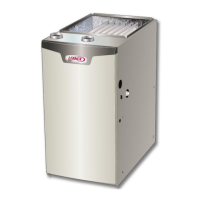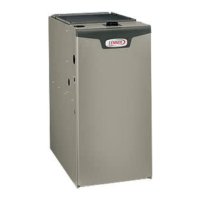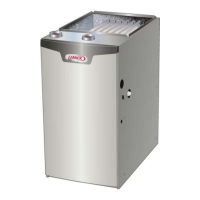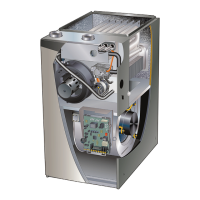Page 67
Intake Piping
The EL296UHV furnace may be installed in either direct
vent or non-direct vent applications. In non-direct vent
applications, when intake air will be drawn into the furnace
from the surrounding space, the indoor air quality must be
considered and guidelines listed in Combustion, Dilution
and Ventilation Air section must be followed.
Follow the next two steps when installing the unit in Direct
Vent applications, where combustion air is taken from
outdoors and ue gases are discharged outdoors. The
provided air intake screen must not be used in direct
vent applications (outdoors).
1 - Use transition solvent cement or a sheet metal screw
to secure the intake pipe to the inlet air connector.
2 - Route piping to outside of structure. Continue with
installation following instructions given in general
guidelines for piping terminations and intake and
exhaust piping terminations for direct vent sections.
Refer to TABLE 24 for pipe sizes.
TYPICAL AIR INTAKE PIPE CONNECTIONS
UPFLOW NON−DIRECT
VENT APPLICATIONS
INTAKE
DEBRIS
SCREEN
(Provided)
NOTE - Debris screen and elbow may be rotated, so that
screen may be positioned to face forward or to either side.
Min 2”
FIGURE 25
TYPICAL AIR INTAKE PIPE CONNECTIONS
HORIZONTAL NON−DIRECT VENT APPLICATIONS
(Horizontal Right−Hand Air Discharge Application Shown)
INTAKE
DEBRIS
SCREEN
(Provided)
OR
NOTE - Debris screen may be positioned straight out
(preferred) or with an elbow rotated to face down.
coupling
PVC pipe
Min 2”
FIGURE 26
Follow the next two steps when installing the unit in Non-
Direct Vent applications where combustion air is taken
from indoors or ventilated attic or crawlspace and ue
gases are discharged outdoors.
1 - Use eld-provided materials and the factory-
provided air intake screen to route the intake piping
as shown in FIGURE 25 and FIGURE 26. Maintain
a minimum clearance of 3” (76mm) around the
air intake opening. The air intake opening (with
the protective screen) should always be directed
forward or to either side in the upow position, and
either straight out or downward in the horizontal
position.
The air intake piping must not terminate too close
to the ooring or a platform. Ensure that the intake
air inlet will not be obstructed by loose insulation
or other items that may clog the debris screen.
2 - If intake air is drawn from a ventilated attic (FIGURE
27) or ventilated crawlspace (FIGURE 28) the
exhaust vent length must not exceed those listed
in table 25. If 3” diameter pipe is used, reduce
to 2” diameter pipe at the termination point to
accommodate the debris screen.
3 - Use a sheet metal screw to secure the intake pipe to
the connector, if desired.

